Brain-booster
/
24 May 2023
Brain Booster for UPSC & State PCS Examination (Topic: Lumpy Skin Disease)

Why in Broadcast?
- The current outbreak of lumpy skin disease started in Gujarat and
Rajashthan in July, 2022. After this it had spread to Punjab, Himachal
Pradesh, Andaman & Nicobar, Uttarakhand, Jammu and Kashmir, Uttar Pradesh,
Haryana, Maharashtra, Madhya Pradesh, Delhi and Jharkhand.
About Lumpy Skin Disease
- The Lumpy Skin Disease (LSD) is caused by a virus called the
Capripoxvirus and this is an emerging threat to livestock worldwide.
- It is genetically associated to the goatpox and sheeppox virus family.
- It infects cattle and water buffalo through vectors such as
blood-feeding insects.
Symptoms
- Major symptoms include the appearance of circular, firm nodes on the
animal’s hide or skin that look similar to lumps.
- Infected animals immediately start losing weight, will have reduced milk
yield and also can have fever and lesions in the mouth.
- Excessive nasal and salivary secretion are other symptoms.
- Pregnant cows and buffaloes may suffer miscarriage due to this disease
and can die.
History of Outbreaks
- The disease has been endemic to most African countries. Since 2012 the
outbreal has been more rapidly in the Middle East, Southeast Europe and West
and Central Asia.
- Since 2019, several outbreaks of LSD have been reported in Asia. In May
this year, Pakistan’s Punjab also reported the deaths of over 300 cows due
to LSD.
- In September 2020, a strain of the virus was discovered in Maharashtra.
Gujarat too has reported cases over the last few years sporadically.
- The point of concern is the number of deaths being reported, and whether
vaccination catches up to the rate at which the disease is spreading.
- According to the World Organization for Animal Health (WOAH), of which
India is a member, mortality rates of 1 to 5 percent are considered as
normal.
Risk to Humans
- The disease is not zoonotic i.e. it does not spread from animals to
humans, and humans cannot get infected with it.
- The milk produced by an infected animal will be fit for human
consumption after boiling or pasteurisation as these processes will kill the
viruses, if any, in the milk.
Challenges
- The disposal of the dead animals is a major issue as improper handling
of the carcasses can cause health and sanitation issues.
- Proper disposal of the carcasses can include incineration or burning of
the bodies at high temperatures, along with disinfection of premises.
Preventing the Spread
- Successful control and eradication of LSD relies on early detection,
followed by a rapid and widespread vaccination campaign.
- The cattle-sheds should be sanitized by eliminating vectors through
application of insecticides and spraying disinfectant chemicals.
- The infected cattle should be immediately isolated from the healthy
stock and the nearest veterinarian should be contacted for treatment of the
infected animal.
- The outbreak to the state government so that the rest of the healthy
herd can be vaccinated using goat pox vaccine.







